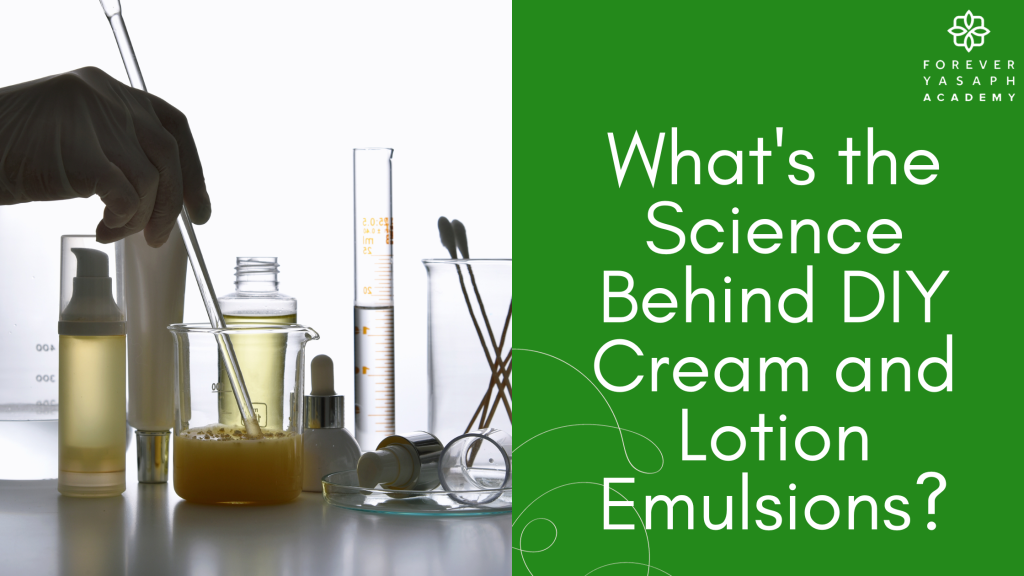
Introduction
In the world of skincare enthusiasts and beauty aficionados, the allure of creating your own creams and lotions is both exciting and empowering. One of the most captivating aspects of DIY skincare is the art of emulsions, which lies at the core of crafting exquisite creams and lotions. Emulsions are more than just the amalgamation of oil and water; they are a delicate balance of science and creativity. In this comprehensive guide, we will delve into the science behind DIY cream and lotion emulsions, demystifying the process and empowering you to create your own skincare treasures.
Emulsions Unveiled: The Chemistry at Play
At its essence, an emulsion is a stable mixture of two immiscible substances – oil and water – combined with the aid of emulsifiers. Emulsifiers possess a unique structure, with a hydrophilic (water-attracting) head and a hydrophobic (oil-attracting) tail. This structure allows emulsifiers to bridge the gap between the water and oil phases, creating a harmonious blend. By creating these bridges, emulsifiers prevent the separation of oil and water, resulting in a smooth, consistent product texture that’s a delight to use.
Emulsification Agents: The Role of Emulsifiers
Emulsifiers are the unsung heroes of DIY skincare formulations. They play a vital role in ensuring that water and oil, which naturally repel each other, coexist seamlessly. Common natural emulsifiers include beeswax, lecithin, and cetearyl olivate/sorbitan olivate. These emulsifiers stabilize the mixture by forming a protective barrier around oil droplets, preventing them from reuniting with other oil droplets. In essence, emulsifiers create a stable microenvironment where water and oil can mingle without separating.
HLB System: The Key to Perfect Emulsions
One of the pivotal concepts in emulsion formulation is the Hydrophilic-Lipophilic Balance (HLB) system. This system helps formulators choose the appropriate emulsifier for a specific formulation. Emulsifiers are assigned an HLB value that reflects their balance between hydrophilic and lipophilic tendencies. Higher HLB values correspond to emulsifiers that are more water-loving, while lower HLB values indicate those that are oil-loving. By selecting emulsifiers with the right HLB value for your oil and water phases, you can achieve a stable and consistent emulsion.
The Emulsification Process: Step by Step
Creating a successful emulsion requires attention to detail and adherence to certain steps:
Step 1: Preparation
Set up a clean and sanitized workspace along with the necessary ingredients, emulsifiers, and containers.
Step 2: Weighing and Heating Phases
Weigh the water and oil phases separately. Heat both phases to around 70-75°C (158-167°F).
Step 3: Combining Phases
Slowly add the water phase to the oil phase while stirring continuously. An immersion blender can help achieve a smooth blend.
Step 4: Emulsification
Continue blending until the mixture thickens and cools to around 40-45°C (104-113°F). This stage is crucial for creating a stable emulsion.
Step 5: Adding Actives and Preservatives
Incorporate active ingredients and preservatives while the mixture is still warm, ensuring even distribution.
Step 6: Cooling and Packaging
Allow the mixture to cool to room temperature before transferring it into sanitized containers, ideally dark glass jars or airless pump bottles.
DIY Emulsions: The Ultimate Customization
The beauty of crafting DIY emulsions lies in the endless possibilities for customization. You have the power to choose carrier oils that suit your skin type, incorporate botanical extracts, and include active ingredients that address your specific skincare needs. This level of personalization allows you to create creams and lotions tailored to your skin’s unique requirements.
Conclusion
The world of DIY skincare formulation is a playground of creativity and science, where the art of emulsions takes center stage. Understanding the science behind emulsification empowers you to create your own skincare treasures with confidence. Emulsions, the heart of creams and lotions, blend the best of oil and water, science and beauty, to pamper your skin in the most luxurious way possible. With the right ingredients, techniques, and a touch of curiosity, you can embark on a journey of crafting personalized skin care wonders that showcase the harmonious marriage of nature and science. Signup for our skincare products formulation course to learn more.
FAQs – What’s the Science Behind DIY Cream and Lotion Emulsions?
A1: An emulsion in skincare is a stable mixture of oil and water, crafted with the help of emulsifiers. It forms the basis for creams and lotions, providing a smooth and consistent texture.
A2: Emulsifiers play a crucial role in DIY skincare by bridging the gap between water and oil phases. Their hydrophilic (water-attracting) and hydrophobic (oil-attracting) properties create a stable blend, preventing separation.
A3: The HLB system is a concept in emulsion formulation that helps choose the right emulsifier. Emulsifiers are assigned an HLB value indicating their balance between water and oil affinity. Matching HLB values to your oil and water phases ensures a stable emulsion.
A4: Common natural emulsifiers include beeswax, lecithin, and cetearyl olivate/sorbitan olivate. These emulsifiers stabilize the mixture and create a protective barrier around oil droplets.
A5: The emulsification process involves preparation, weighing and heating phases, combining phases, emulsification with continuous stirring, adding actives and preservatives, and finally, cooling and packaging.
A6: The beauty of DIY emulsions lies in customization. You can choose carrier oils, botanical extracts, and active ingredients tailored to your skin type and specific skincare needs.
A7: Cooling and packaging are crucial steps to allow the emulsion to stabilize and cool to room temperature before transferring it into containers. Dark glass jars or airless pump bottles are ideal for preserving the emulsion.
A8: Understanding the science behind emulsification empowers skincare enthusiasts to create personalized skincare treasures with confidence. It allows for informed ingredient selection and technique application.
A9: Absolutely! To delve deeper into the world of skincare formulation, consider signing up for our Skincare Products Formulation Course. It’s a comprehensive guide to mastering the art and science of crafting your own skincare wonders.
